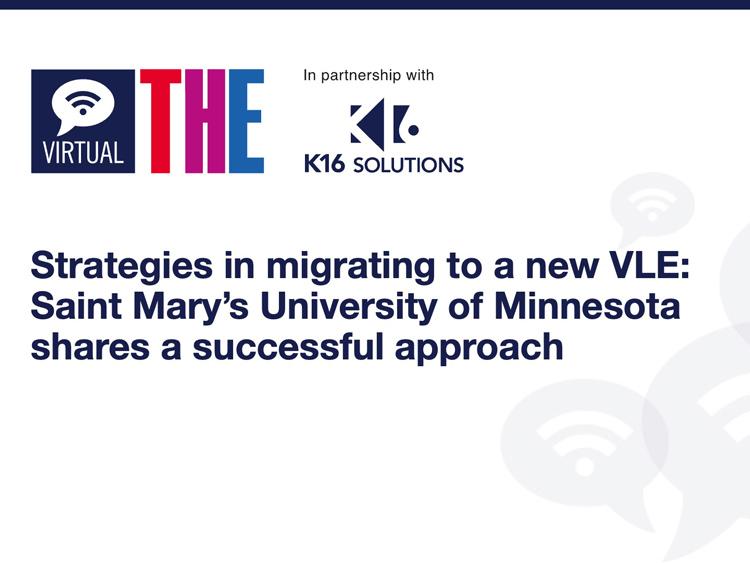Inconsistent virtual learning environment (VLE) spaces and ill-defined work expectations were among problems that students highlighted during the pandemic. Addressing them – with standardised pages and a wraparound teaching and learning model – also provided useful insights into blended learning, belonging and collegiate partnership.
Like faculty at many educational institutions, we at Leeds Trinity University (LTU) were keen to learn the lessons from the swift pivot to online learning during Covid from both staff and student perspectives. Thematic analysis of focus group data conducted at LTU in 2020-21 highlighted the importance of both belonging and connections, and digital social spaces.
- Resource collection: The post-pandemic university: how to serve the Covid generation
- How to get students to play their part in the flipped classroom
- Five key competencies for successful digital teaching
Barriers to these included varying presentation and resourcing of the VLE and inconsistent expectations of what students needed to do in relation to learning, inside and outside the classroom. This feedback became the foundation for an institution-wide reform of our VLE, our pedagogical delivery and the interface between these aspects of learning.
The solution part 1: reforming the VLE space
Students expressed their difficulties navigating the different layouts of VLE pages (in our example Moodle). Not only did the formatting of the VLE space change between modules, the quantity of learning resources and how these were “packaged” for students varied vastly. For students, finding relevant information was onerous. Moreover, some module VLE pages were used as a repository for extensive resources, in some cases exceeding 400.
Building on this and research on implementing VLE minimum standards, the university explored the options for rolling out a VLE page template that was consistent across all modules and purposefully designed for active engagement, with carefully scaffolded resources. We worked with Advance HE in adopting the University of Surrey’s Active Digital Design approach (ADD), where VLE spaces are constructed within a template as an active space for student engagement and learning.
This institutional shift needed whole-staff engagement. We achieved this by:
- securing the leadership and support of senior management
- securing resources and time for staff training
- building collegiate partnership working between academic and digital learning colleagues
- adopting a “train the trainer” approach, whereby Advance HE trained staff from each academic unit, who then trained their colleagues.
Mindful of the variance in colleagues’ digital skills and confidence, we chose a VLE template and model for scaffolding resources that did not require high-level technologies and skills. Our focus was on a basic digital skill set that would have a high impact in terms of student engagement and depth of learning.
The solution part 2: implementing an institutional teaching model
This shift from the VLE being a resource repository to a platform for active engagement incorporated our blended approach to learning developed during 2020-21. In this simple wraparound model, asynchronous online pre-session activities and post-session consolidation bookend in-person synchronous teaching. Each week’s learning on the VLE page contains a clearly labelled, scaffolded set of resources for each stage (the pre-live-post model or PLP), with clear timing guidance (for example, one-three-one hours).
In building these blended-learning experiences, we drew on Garrison and Kanuka’s 2004 definition of blended learning as the “thoughtful integration of classroom face-to-face learning experiences with online learning experiences”, with the emphasis on purposeful in-person and digital design.
Student and staff reflections on the VLE changes
Feedback from a student-led VLE audit was universally positive for the layout and structure of the module pages. In particular, students commented on:
- consistent structure
- ease of navigation
- clear and accessible information
- friendly, accessible language
- clearly set tasks with expectations and guidance.
Regarding our wraparound pedagogical model, a content analysis of 459 module evaluation open comments related to pre/post activities resulted in 294 comments categorised as positive and 156 as negative. Considering all comments, students were positive about the PLP structure if activities:
- were relevant and engaging
- fed into and were built upon in the live session
- enhanced their understanding
- extended their learning beyond the classroom
- were manageable in terms of time and challenge
- were released in a timely way
- were clearly communicated.
Students’ feedback on blended delivery was reflected in discussions with staff across all subject areas, who liked the structure of the PLP model and the principles of it linking into live sessions to extend learning beyond the classroom. The overriding difficulty from a staff perspective was structuring and delivering live sessions that were predicated on engagement with the pre-activities.
Key takeaways: consistency, purpose, scaffolding
Rolling out a consistent VLE space helped students engage with their learning. Embedding the PLP model within these spaces helped ensure students were prepared for active engagement in their on-campus learning.
However, online activities within the VLE space need to be:
- consistently signposted with clear descriptions and instructions
- purposefully designed with varied activities for active engagement
- scaffolded both within the module and through the levels
- differentiated to support weaker students and extend more able students
- have compulsory and optional tasks (related to differentiation).
Access to clearly designed digital spaces and purposefully scaffolded resources has been a positive takeaway from that rapid pivot to online teaching in 2020. New challenges have emerged related to facilitating attendance and engagement, and the form teaching/learning takes, be it blended, hybrid, hyflex or distance. Central to meeting these challenges is us learning and moving forward together as an academic community, a community that shares the things that didn’t quite work as well as sharing the successes.
Alison Torn is associate professor (learning and teaching) at Leeds Trinity University.
If you found this interesting and want advice and insight from academics and university staff delivered direct to your inbox each week, sign up for the Campus newsletter.




comment